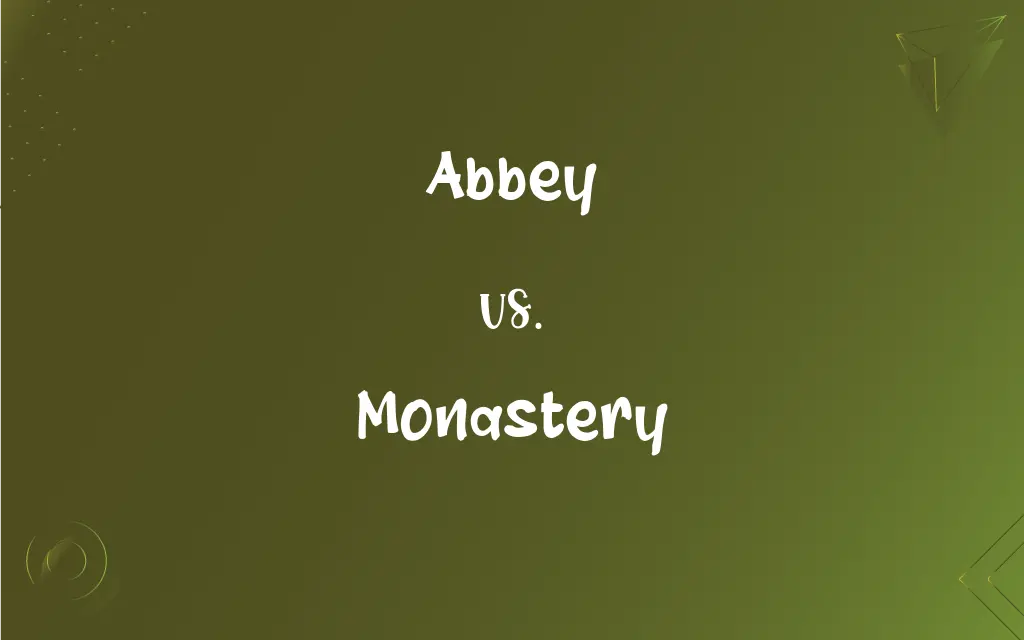Abbey vs. Monastery: What's the Difference?
Edited by Aimie Carlson || By Janet White || Published on November 21, 2023
An abbey is a religious building complex housing a community of monks or nuns, often led by an abbot or abbess, while a monastery is a broader term for such religious communities, regardless of leadership.

Key Differences
An abbey is a complex of buildings forming a religious community, typically headed by an abbot or abbess. A monastery refers more generally to any residential religious community, where monks or nuns live in seclusion from the outside world.
Abbeys usually imply a degree of self-sufficiency and often include facilities like churches, living quarters, and gardens. Monasteries focus more on the aspect of communal living and religious devotion, which may or may not include extensive facilities.
The term "abbey" often connotes not just the buildings but the entire religious community and its practices. In contrast, "monastery" primarily refers to the physical residence and the monastic lifestyle of its inhabitants.
Historically, abbeys have been centers of learning and cultural development, along with religious functions. Monasteries, while also centers of learning in many cases, place a greater emphasis on spiritual practice and discipline.
An abbey typically holds a certain level of prestige and importance within its religious order, often being a hub for regional religious activities. A monastery, however, can range from being a significant religious center to a more humble, isolated community.
ADVERTISEMENT
Comparison Chart
Leadership
Headed by an abbot/abbess
May or may not have specific leadership
Components
Includes church, living quarters, and often other facilities
Focuses on residential quarters and spaces for religious practice
Community
Encompasses both the buildings and religious community
Primarily the community living a monastic life
Historical Role
Often centers of learning and culture
More focused on spiritual practice and discipline
Prestige
Generally holds more prestige within a religious order
Varies from significant centers to humble communities
ADVERTISEMENT
Abbey and Monastery Definitions
Abbey
A building housing monks or nuns and a church.
The abbey's church was a place of great spiritual significance.
Monastery
A community living in spiritual seclusion.
Life in the monastery was dedicated to prayer and meditation.
Abbey
A religious complex led by an abbot or abbess.
The medieval abbey was known for its impressive architecture.
Monastery
A retreat for those seeking a life of contemplation.
Many visited the monastery for periods of reflection.
Abbey
A prestigious religious institution within certain orders.
The abbey played a central role in the region's religious life.
Monastery
A residence for monks or nuns practicing religious life.
The monastery was set in a tranquil, secluded location.
Abbey
A Christian monastic community, often self-contained.
The abbey produced its own food and maintained beautiful gardens.
Monastery
A building or complex for a religious order.
The ancient monastery stood atop the hill for centuries.
Abbey
Historically, a center of religious learning and culture.
The ancient abbey housed an extensive library.
Monastery
A place for monastic living and religious devotion.
The monastery's daily schedule revolved around spiritual disciplines.
Abbey
A monastery supervised by an abbot.
Monastery
A community of persons, especially monks, bound by vows to a religious life and often living in partial or complete seclusion.
Abbey
A convent supervised by an abbess.
Monastery
The dwelling place of such a community.
Abbey
A church that is or once was part of a monastery or convent.
Monastery
A residence for monks or others who have taken religious vows.
Abbey
The office or dominion of an abbot or abbess.
Monastery
A house of religious retirement, or of secusion from ordinary temporal concerns, especially for monks; - more rarely applied to such a house for females.
Abbey
A monastery or society of people, secluded from the world and devoted to religion and celibacy, which is headed by an abbot or abbess; also, the monastic building or buildings.
From 1199 to 1203 William Punchard was the abbot of the abbey of Rievaulx, which was part of the Cistercian order of monks.
Monastery
The residence of a religious community
Abbey
The church of a monastery.
Abbey
(British English) A residence that was previously an abbatial building.
Abbey
A monastery or society of persons of either sex, secluded from the world and devoted to religion and celibacy; also, the monastic building or buildings.
Abbey
The church of a monastery.
Abbey
A church associated with a monastery or convent
Abbey
A convent ruled by an abbess
Abbey
A monastery ruled by an abbot
FAQs
Are monasteries only for men?
No, they can be for men (monks) or women (nuns).
Do abbeys always have a church?
Typically, but the size and prominence can vary.
What is an abbey?
A religious complex with a community led by an abbot/abbess.
What defines a monastery?
A residence for a religious community living in spiritual seclusion.
Can monasteries be found in all religious traditions?
They are more common in Christian, Buddhist, and Hindu traditions.
Are abbeys part of a larger religious order?
Often, they are significant centers within an order.
What is the architecture of a monastery like?
Often simple and functional, focusing on spiritual practices.
Is an abbey different from a convent?
Yes, convents are specifically for nuns, while abbeys can be for monks or nuns.
Can women live in an abbey?
Yes, in abbeys headed by an abbess.
What's the main focus of life in a monastery?
Prayer, meditation, and spiritual discipline.
Can abbeys be tourist attractions?
Many, especially historic ones, are popular tourist sites.
Can anyone visit a monastery?
This varies, but many welcome visitors for retreats.
Do abbeys function as educational centers?
Historically, many have been centers of learning and culture.
Are all abbeys large and prestigious?
Not all; the size and influence can vary widely.
What is the role of an abbot or abbess?
They are the spiritual and administrative leaders of an abbey.
Are new abbeys still being established?
Yes, though the frequency depends on the religious context.
Do people live permanently in monasteries?
Yes, many monks and nuns take lifelong vows.
How do monasteries support themselves?
Through agriculture, donations, and sometimes by making goods.
Do monasteries offer educational programs?
Some do, especially those in traditions like Buddhism.
Is there a hierarchy in abbeys?
Yes, typically governed by religious hierarchy.
About Author
Written by
Janet WhiteJanet White has been an esteemed writer and blogger for Difference Wiki. Holding a Master's degree in Science and Medical Journalism from the prestigious Boston University, she has consistently demonstrated her expertise and passion for her field. When she's not immersed in her work, Janet relishes her time exercising, delving into a good book, and cherishing moments with friends and family.
Edited by
Aimie CarlsonAimie Carlson, holding a master's degree in English literature, is a fervent English language enthusiast. She lends her writing talents to Difference Wiki, a prominent website that specializes in comparisons, offering readers insightful analyses that both captivate and inform.






































































